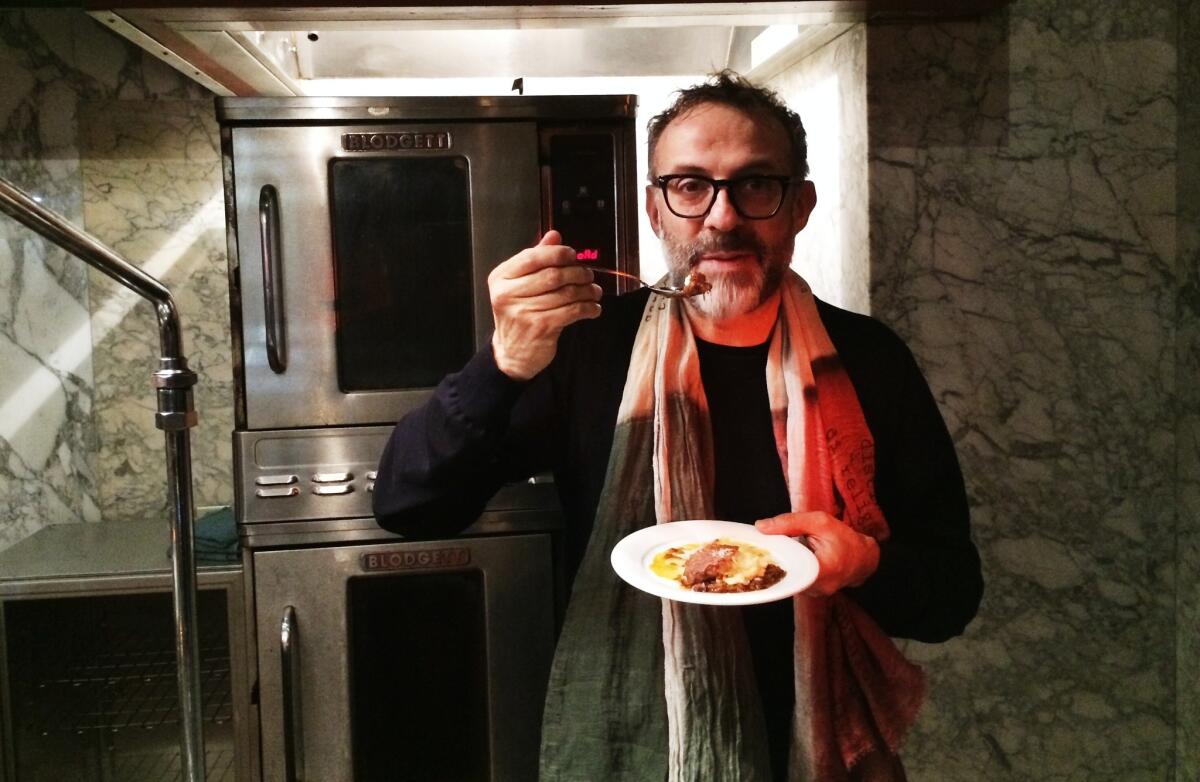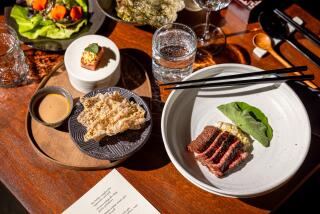The night Massimo Bottura met Chi Spacca

- Share via
It was the culinary equivalent of the “Odd Couple” Tuesday night when the emphatically primitivist restaurant Chi Spacca hosted a book party for the emphatically modernist Italian chef Massimo Bottura. What was most interesting, though, was how both ultimately seemed to be on the same wavelength.
Chi Spacca is a space built on meat — cured, grilled, roasted, but undeniably still meat. Bottura’s restaurant, Osteria Francescana, and his just-published cookbook “Never Trust a Skinny Italian Chef” take a decidedly more theoretical approach.
Typical is the dish Bottura calls La Dame et son Chevalier (The Crunchy Part of the Lasagna). It is made of four triangles -- two Parmigiano-Reggiano wafers, two of spinach pasta (first boiled and then baked until crisp) -- perched over spoonfuls of ragu and bechamel, with a long stripe of tomato terrine running down the side.
This kind of imagination has earned Osteria Francescana in Modena three Michelin stars and a ranking as one of the five best restaurants in the world. The book is a wonder — full of photos of food, setting and whimsy (though a close-up of a section of his record collection displays an unfortunate fondness for Dan Fogelberg).
But if you’re looking for recipes, they’re going to be way in the back of the book, in tiny type. Instead, what you get are short essays on the philosophical and technical roots of each dish. They’re fascinating windows into the workings of one of cooking’s most creative minds.
And if you’re a chef used to making tomahawk pork chops — no matter how ungodly good they are — they can be a little intimidating.
“When I knew we were going to do this dinner, I spent about a month of wondering,” says Chi Spacca chef Chad Colby, who is loved for his house-cured salumi and 42-ounce bistecca Fiorentina. “I like to envision success, but what are we going to do with this? We want to respect what he does, but we have to stay true to ourselves, to our skill sets and to our flavor profiles.”
Colby settled on a menu of salumi and the restaurant’s famed focaccia di Recco, a Parmesan souffle served over ragu, and shredded roast pork shoulder. The only overt nod to Bottura was pastry chef Dahlia Narvaez’ take on the chef’s Oops, I Dropped the Lemon Tart — a deliberately spattered mixture of lemon gelato, tart crust and zabaglione.
“I figured we’d do best staying true to the flavors he grew up with. I think of it as our homage to Modena,” Colby says.
It turned out to be a brilliant choice. Because as theoretical and, yes, even wacky as Bottura’s food can be, it’s all rooted in a profound connection to a specific culture and set of flavors. He plays jokes on traditional dishes, but they’re the kinds of jokes that can only be played by someone who understands and deeply loves the subject he’s ribbing.
What Bottura is offering is a distillation of classic cooking, the essential flavors turned on their sides and viewed from an unusual angle.
Of that deconstructed lasagna, Bottura says “ It’s like when you chew a Parmigiano Reggiano crust, it immediately takes you back to childhood. The crunchy lasagna crust … that’s when your grandmother would bring a big lasagna to the table and the first thing everybody would reach for would be the little burnt edges. We’re trying to connect you back with that joy.
“We need to have a sense of humor because we need to leave things a little imperfect. You have to keep a little space open in your life for poetry.
“Our lives are so full of obligation but if you don’t keep a little sense of humor, how do you live? We need to be able to play jokes, to be ironic. There is joy in food.”
Are you a food geek? Follow me on Twitter: @russ_parsons1
More to Read
Eat your way across L.A.
Get our weekly Tasting Notes newsletter for reviews, news and more.
You may occasionally receive promotional content from the Los Angeles Times.








